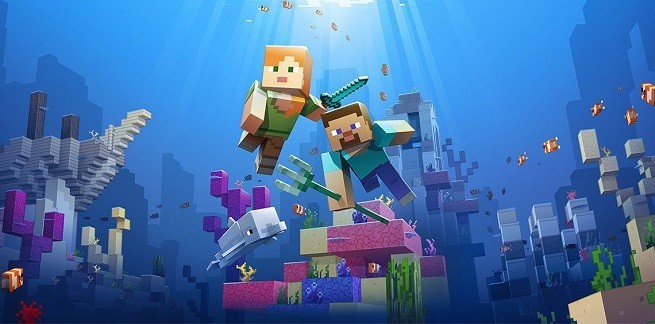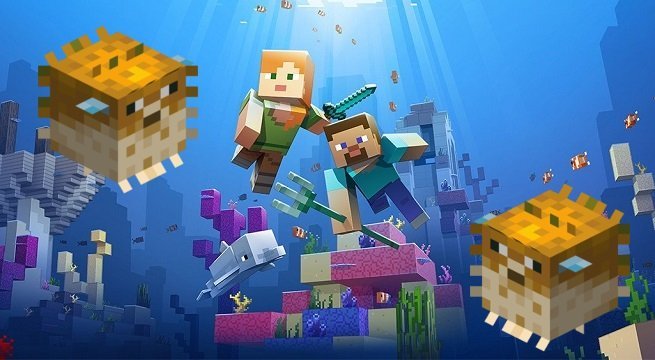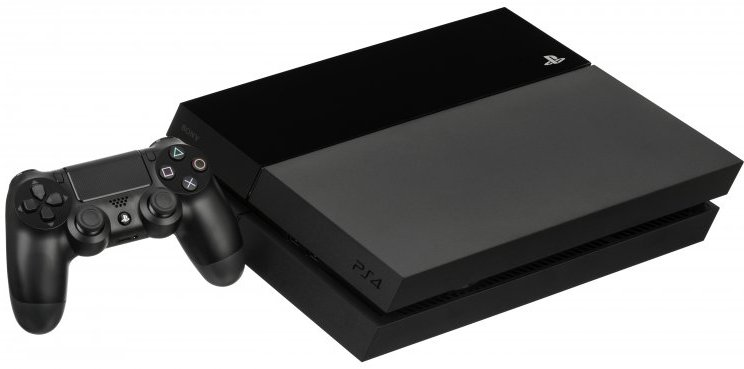
by Stone Marshall | Jun 22, 2018 | Awesome Book News, Free, Intro, Minecraft News, Minecraft questions, news, parent-news, State of Stone, Stone Marshall Book News, Stone Marshall Books, Stone Marshall Club, Stone Marshall Minecraft Adventures, Uncategorized |
Nintendo and Microsoft have teamed up for a Minecraft commercial that seemed strangely historic for those of us who grew up thinking about console generations as a series of figurative wars. Both consoles were highlighted, both company’s logos were on the screen and the hook was the ability to play the same game across two consoles or using a gaming PC.
Sony was, of course, not involved with any of this. The company doesn’t support cross-platform play between consoles, and limits the use of Fortnite accounts on other platforms if they’ve ever been used on the PlayStation 4. In the case of Minecraft, Sony’s excuse from 2017 was that cross-platform support would make PlayStation 4 players less safe, a claim that Microsoft’s Phil Spencer rejected out of hand.
But it might be as simple as an economic issue.
“BTW when I was at Sony, the stated reason internally for this was money,” industry veteran John Smedley tweeted. “They didn’t like someone buying something on an Xbox and it being used on a Playstation. Simple as that. Dumb reason, but there it is.” Smedley used to be the president of Daybreak Game Company, which was once called Sony Online Entertainment. He’s now the general manager of Amazon Game Studios. The tweet has since been deleted.
This is the explanation that actually makes the most sense, and we can see the account issue come up in the FAQ section of today’s Minecraft blog post talking about the release of the “Better Together” update for Minecraft on the Nintendo Switch:
Q: What’s a Microsoft Account and why do I need it for a Nintendo Switch?
A: A Microsoft Account is a free account you can sign-in on device that allows Minecraft players on Switch to play with others on non-Nintendo devices like iOS, Android, Xbox One and Windows 10 via cross-play, Realms or Servers. Having a Microsoft Account also enables the portability of your MINECOINS and marketplace purchases to other devices and platforms. To create an account click here.
The game industry is turning into a business of accounts, not hardware, and you can guess how enthusiastic Sony must be about the idea of someone logging into a Microsoft account from the PlayStation 4.
But outside of the terminology, it’s the last part of the description that has to stick in Sony’s craw: The use of the Microsoft account is what allows someone to give Microsoft money for in-game items, and then bring those items onto other platforms. Sony only gets a cut of the revenue if these purchases are made on its platform, which is why this is a topic it’s willing to be so stubborn about.
And this is likely what Sony is afraid of in the grand scheme of things. Imagine a world where game accounts move from hardware to hardware willy nilly, and purchases made on one platform were accessible everywhere. Where’s the profit for the platform holders? If you buy all your content for a free-to-play game on another platform and use that content on the PlayStation 4, the hardware just becomes a conduit through which you play games you paid for on other platforms.
The play part of cross-platform play is the least important aspect of this issue for Sony. The important issue is the use of third-party accounts to purchase things away from Sony hardware, and then using them on Sony’s platform.
So why don’t Microsoft and Nintendo care? My guess is that Nintendo is Nintendo, a company that has already played by its own rules and has ridden that sense of adventure directly into huge profits, and Microsoft is currently way behind Sony in the console business, and this is a way to bring attention to something the Xbox can do that Sony refuses to match on the PlayStation 4.
But if Sony lets Minecraft purchases from Microsoft come onto the PlayStation 4, and it lets purchases from Epic Games come onto the PlayStation 4 through the accounts tied to other games and companies, it’s not going to be able to deny anyone else, which means that Sony would lost the ability to guarantee itself a heavy cut of all the virtual currency and in-game items being sold for those games.
That’s the nightmare Sony is worried about, and that’s why it’s been so unwilling to budge. The question is how much pain the company is willing to endure before it decides the lost profit is worth the positive press and player contentment.

by Stone Marshall | Jun 22, 2018 | Awesome Book News, Free, Intro, Minecraft News, Minecraft questions, news, parent-news, State of Stone, Stone Marshall Book News, Stone Marshall Books, Stone Marshall Club, Stone Marshall Minecraft Adventures, Uncategorized |
With the Electronic Entertainment Expo kicking off Tuesday in Los Angeles, Facebook shared new data related to how its users are talking about the video game convention on both Facebook and Instagram.
Over the past seven days, 17 million Facebook users made 55 million posts, likes and comments related to E3, as well as the major games and companies at the show. Of these users, 61 percent were men and 39 percent were women. In addition, 33 percent of users were between 25 and 34 years old.
On Facebook, the top five countries talking about E3 and the major games and brands over the past seven days were:
U.S.
U.K.
Australia
Brazil
Canada
The most-talked-about video-game publishers on Facebook from June 9 through 11 were:
Sony
Microsoft
Nintendo
Bethesda
Ubisoft
The most-talked-about games on Facebook during that period were:
Minecraft
Kingdom Hearts
The Legend of Zelda
Resident Evil
Super Mario
Fallout
Fortnite
Call of Duty
EA FIFA
The Elder Scrolls
Altogether, the most discussed female video-game characters on Facebook over the past seven days were:
Princess Zelda
Lara Croft
Bayonetta
Aya Brea from Parasite Eve
Cortana from Halo
Finally, the top gaming-related Facebook video (in terms of video views) over the past seven days was the official reveal trailer for Electronic Arts’ FIFA 19.
Over on Instagram, 17 million users had “around” 46 million interactions surrounding the E3 press conferences, video-game consoles, video-game titles and other related terms over the past seven days.
On Instagram, the top video-game-related hashtags from the past seven days were:
#ps4
#xbox
#fortnite
#gaming
#gamer
The “most-buzzed-about” games on Instagram over the past seven days were:
Fortnite
Minecraft
Call of Duty
PlayerUnknown’s Battlegrounds (also called PUBG)
Super Mario
In a statement, Franco De Cesare, director of console and online gaming at Facebook, said, “Every E3, we see people come to Facebook to connect around the games and publishers they love—and this year is no exception. We’ve seen this community of gamers continue to grow and evolve each year, with women and female characters entering a growing portion of the conversation. For the first time, we’re also excited to share the gaming conversation on Instagram, where gamers bring the same passion for the games they love as they always have on Facebook.”

by Stone Marshall | Jun 21, 2018 | Awesome Book News, Free, Intro, Minecraft News, Minecraft questions, news, parent-news, State of Stone, Stone Marshall Book News, Stone Marshall Books, Stone Marshall Club, Stone Marshall Minecraft Adventures, Uncategorized |
Amino, a social networking platform founded by two entrepreneurs who graduated from Northeastern University, has raised $45 million during its third round of financing.
Amino centers on smartphone apps that connect users who share an interest in topics that appeal to relatively small groups of people, including Pokémon, Minecraft, and Dr. Who.
“We are trying to connect the world through people’s passions,” said Ben Anderson, the co-founder and CEO of Amino. “We want to create an engaged community for every interest in the world.”
Amino apps have been downloaded tens of millions of times by users in more than 100 countries, Anderson said. He said the average user spends 70 minutes per day on the platform—almost as much as Snapchat and Facebook combined.
“Most investors have never seen anything like this,” said Anderson, who graduated from Northeastern in 2012 with a degree in music. “It’s a massive opportunity and the users love it.”
Amino plans to use the new funding to improve the platform’s voice and video chat features, Anderson said. “We want to bring real-time connections to life even more.”
The app is available in seven languages—English, German, Spanish, Russian, Arabic, French, and Portuguese—a testimony to its global appeal. “We are reminded every day that what we are building applies to cultures all over the world,” Anderson said.
Ben Anderson, left, and Yin Wang co-founded Amino in 2011. Photo by Meryl Natow/Amino
One of Amino’s most popular features is the “Amino Creator,” which enables users to custom-design communities of their own. Three such communities have more than 1 million members, including a community dedicated to pop music from South Korea.
Anderson acknowledged Northeastern for helping him shape Amino into a social networking platform that appeals to a global audience. IDEA, Northeastern’s student-run venture accelerator, awarded him $20,000 in gap funding, connected him with an accountant, and perfected his business plan.
“Honing a business plan forced me to think about where I saw Amino going,” said Anderson, who was named to Forbes’ 30 Under 30 Class of 2017, a list comprising 600 of the nation’s brightest young people. “For a young founder, that guidance was invaluable and helped me to avoid unnecessary pitfalls.”
Amino has raised more than $72 million since 2014. Marc Meyer, the co-director of Northeastern’s Center for Entrepreneurship Education, said that Amino has raised more venture capital than any other IDEA venture.
“Amino,” he said, “is highly innovative.”
Anderson said Amino does not make money. But he and co-founder Yin Wang are planning to build tools that would allow community curators to sell digital goods to users while taking a cut of the revenue for themselves.
“We’re really excited because we want to create a community for every interest in the world,” Anderson said. “We’re getting closer to that as times goes on.”

by Stone Marshall | Jun 21, 2018 | Awesome Book News, Free, Intro, Minecraft News, Minecraft questions, news, parent-news, State of Stone, Stone Marshall Book News, Stone Marshall Books, Stone Marshall Club, Stone Marshall Minecraft Adventures, Uncategorized |
The official Nintendo UK Store now has the physical edition of Minecraft for the Nintendo Switch available for pre-order. The incredibly popular sandbox title will be available for purchase on 21st June and will cost you £24.99. Here’s the details:
Minecraft is a game about placing blocks and going on adventures. Explore randomly-generated worlds and build amazing things from the simplest of homes to the grandest of castles.
This Bedrock version of the game contains all the great previously released content, including the Super Mario Mash-Up Pack exclusive to Nintendo systems and all DLC, but now allows players to connect with friends on non-Nintendo systems via cross-platform play.

by Stone Marshall | Jun 20, 2018 | Awesome Book News, Free, Intro, Minecraft News, Minecraft questions, news, parent-news, State of Stone, Stone Marshall Book News, Stone Marshall Books, Stone Marshall Club, Stone Marshall Minecraft Adventures, Uncategorized |
Even if Sony has started to mention new information about the company’s future PlayStation 5, it seems that they are not done with PlayStation 4 either. It is still going strong and consumers don’t feel the need for a new hardware or consider the platform out-dated. So, the discussions about Sony’s products are either focused on the future PlayStation 5 or on keeping the PlayStation 4 on the market for longer.
Sony is almost as important as Nintendo, a position which will enable the company to gain even more market share in the future but it shouldn’t be distracted by using more resources for one console than the other.
The PlayStation 4’s popularity
In 2018, PS4 will be on the market for five years. Sony may follow the PlayStation 3’s trend of lasting over seven years and go even further to confirm that it will last for three years or more, breaking the company’s record of such a lasting presence. Its lifespan may have been extended, but fans need to know what a future PlayStation will bring to the table. The company will consolidate the PlayStation 4 in order to catch the consumers’ attention and raise brand awareness for its next console.
The shift from the SNES-era systems to the PlayStation and from the PlayStation to the PlayStation 2 made Sony what it is today. The PS4 has introduced the 4K gaming together with Xbox One games but it seems that it would remain the last “traditional” console generation after the PlayStation 5 will be launched. However, the technological advancement will be a subtle one, making it easy to understand that consumers are really satisfied with the PS4.
The future PlayStation 5
Sony’s console will be the closest thing to a cutting-edge successor, leaving the days of testing proprietary hardware and Emotion Engine far behind. Whatever configuration of hardware Sony will use, it will look almost as a linear evolution of the PS4. The PS5 is expected to perfectly run your digital library of PS4 games, depending on the Blu-Ray drive. Since losing an entire library of digital games would be a great drive not to switch to a different platform, it would additionally lock consumers into their console choice.
Sony hasn’t made all the decision regarding the PlayStation 4 yet but it would be surprising if the company hadn’t already tried PS5 prototypes with a hybrid home console model for Switch or even with an eGPU for a portable device. However, in such cases, the hardware would likely be compatible with the PS4. The next console model will certainly have an upgraded hardware for the first time in Sony’s platforms.

by Stone Marshall | Jun 20, 2018 | Awesome Book News, Free, Intro, Minecraft News, Minecraft questions, news, parent-news, State of Stone, Stone Marshall Book News, Stone Marshall Books, Stone Marshall Club, Stone Marshall Minecraft Adventures, Uncategorized |
When it comes to mobile games, there aren’t that many titles which can even compare with Clash of Clans. The developer who is in charge of Clash of Clans is constantly rolling out new updates which are filled with lots of in-game goodies such as new features, rewards and even content! In fact, a brand-new Clash of Clans update which changes the game’s version number to “10.134.17” is now available.
Clash of Clans 10.134.17 Update
The new update measures in at 98.6MB and it requires a minimum of Android 4.0.3 Ice Cream Sandwich operating system in order to work. As you can probably tell already, the new update is exclusive to Android smartphone owners and iOS fans will need to wait a little more until it becomes available for them too.
Bug Fixes and Software Improvements
Android fans should be happy to know that they are going to get their hands on this update ahead of everyone else because it comes with bug fixes and software improvements. While most people don’t pay that much attention to bug fixes and software improvements, they are the ones which make sure that Clash of Clans runs without any issues and that it never randomly crashes in the middle of combat.
Highlight Features
Now that we talked about the latest Clash of Clans update, let’s check out some of the game’s highlight features and see what it’s all about. First off, the game is free to play but readers shouldn’t think that the game is not of premium quality because of this.
Clash of Clans offers an awesome gaming experience where people get to build their own villages and then slowly, but surely transform them into unbeatable fortresses. In addition, Clash of Clans features different mods where players can fight against their foes and take their trophies.





